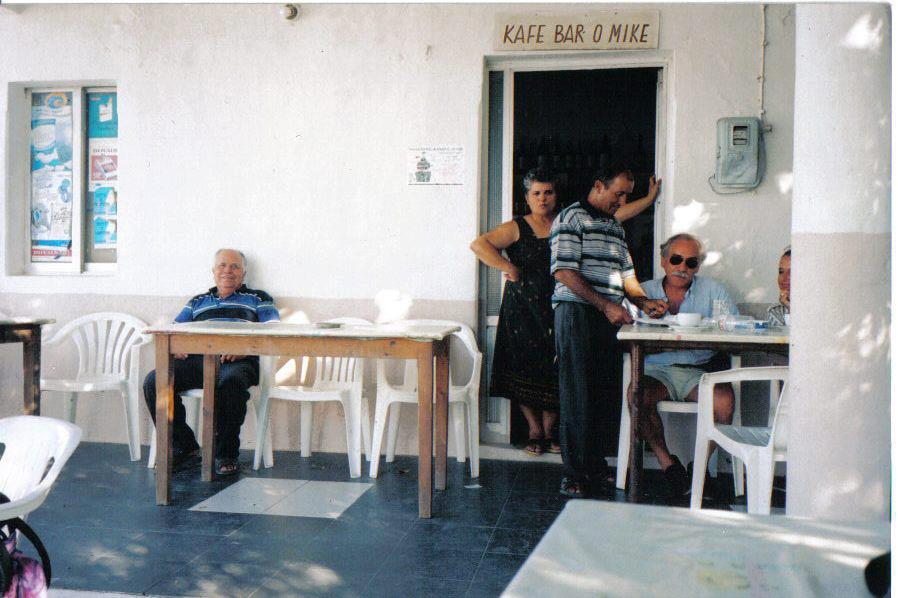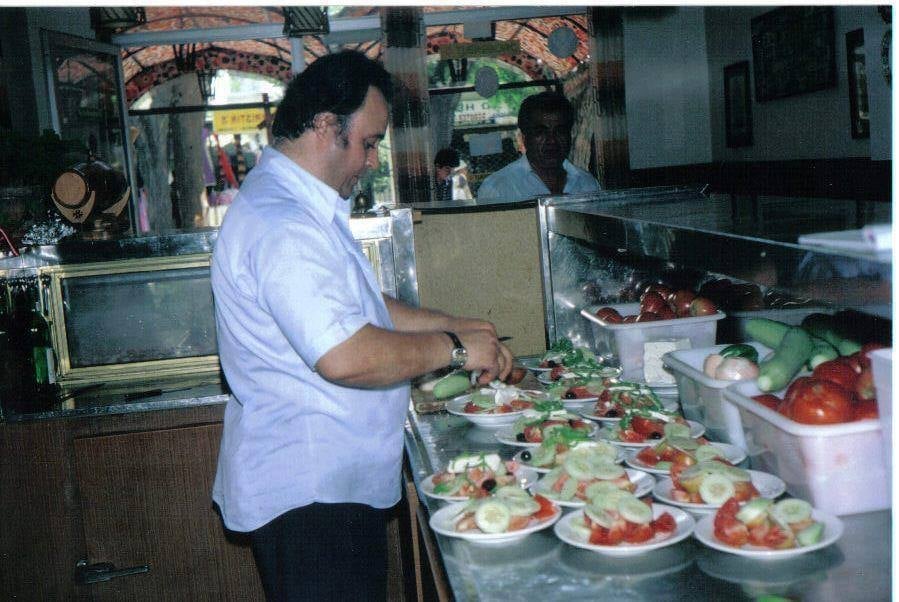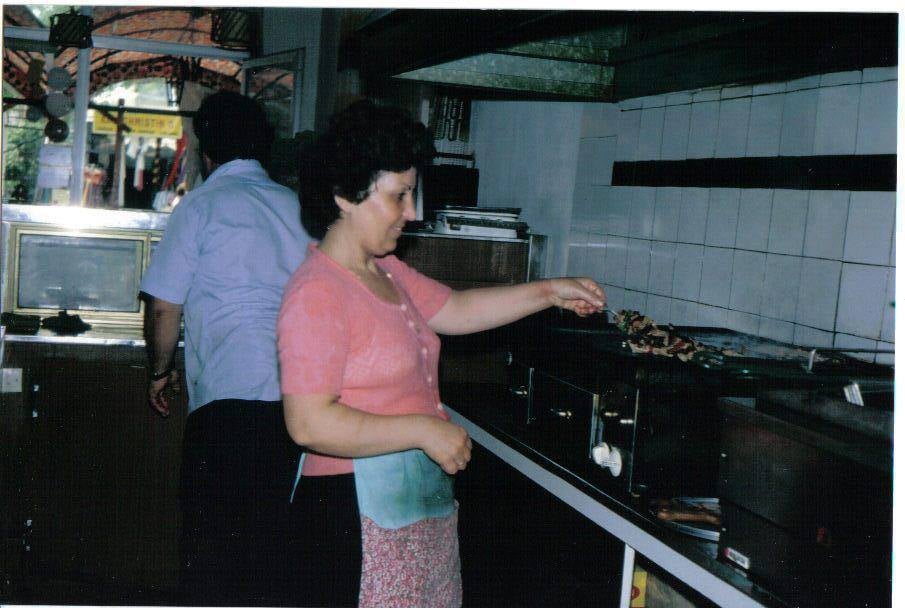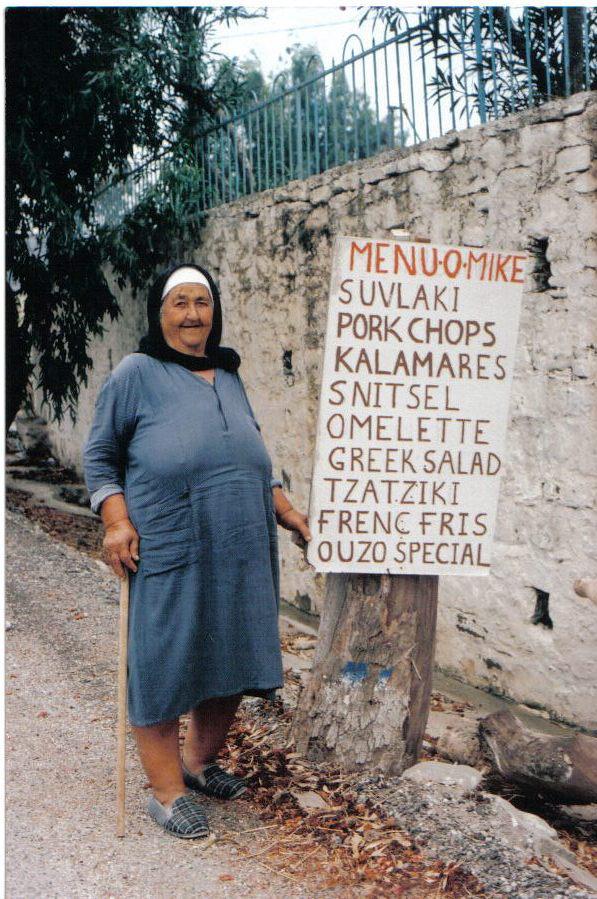Famous European Foods
.Famous European Foods are a part of its many wonderful and timeless treasures that originated centuries ago.
Your senses will experience not only a unique blend of tastes, flavors and cooking experiences.
Many of these foods have become famous around the world such as the French crepes, bouillabaisse, cassoulet, and baguette, Italy's pasta and pizza, the British classic Sunday roast and fish and chips, Spain's paella and the Greek souvlaki, yiros and baklava...

Greek Feta
Greek cheeses are an important part of the Greek cuisine.
Feta is the national cheese of Greece consisting of sheep and goat's milk (with a maximum of 30% goat milk).
Sheep's milk gives the cheese a more buttery flavor, while goat cheese makes it harder and milder in flavor.
Creamy, crumbly feta is a soft, white, rindless, cheese that is salty and tangy because it is stored in barrels filled with brine (salt and water) for a minimum of 2 months and up to 12 months.
Storing feta in plain water will help keep its crumbly texture.
Sheep's milk cheese is higher in fat and double the protein than goat's milk cheese, it contains high levels of phosphorus and calcium and has vitamins A and C, potassium and iron as well as phytonutrients and antioxidants.
Feta can be used in salads, desserts, baked goods, casseroles, mezethes and as a table cheese or you can simply slice a piece of feta, add olive oil, sprinkle oregano over it and enjoy eating it with bread and olives.
Spices may include cumin, oregano, thyme, rosemary, and others.
Feta marinated in oil and flavored with herbs, spices or lemon zest makes a great addition to an antipasto plate or toasted sandwich.
The traditional Greek salad with tomatoes, cucumber, bell peppers, onions and olives would not be complete without the creamy, crumbly feta cheese.

Greek Yiros
Yiros is stacked roasted meat on a vertical spit which turns slowly and sliced off in thin shavings as it cooks.
The name "yiros" comes from the Greek word meaning "turn".
The Greeks created a more Greek-looking variation of the Turkish kebab and its popularity grew throughout the 20th century in Greece and beyond.
By 1970, yiros wrapped sandwiches were also a popular fast food.
The main difference between yiros and souvlaki is the way the meat is cooked.
Yiros is roasted vertically whereas souvlaki meat is cooked horizontally, on skewers that are rotated on a grill.
Legend says that yiros dates back to thw Hellenistic Period, when the army of Alexander the Great skewered and roasted various meats on swords over the fire.
It is typically served wrapped in an oiled, lightly grilled pita and filled with tomato, onion, and tzatziki made from yogurt, cucumber, garlic, and various spices.
Yiros meat used is typically lamb, beef, pork, or chicken.
Depending on the consumer's taste, other ingredients may include lettuce and french fries, topped with tzatziki sauce or, sometimes in northern Greece, ketchup or mustard.

Italian Pizza
Pizza today can be found around the world.
Italian pizza is a flatbread made from yeast and comes in various shapes and generally topped with tomato sauce, cheese and other tasty choices of ingredients which are then baked in a wood-fired oven.
Italian pizza stands out above all because the Italians have become the master's to make the perfect pizza.
Tradition says that the modern pizza was first created in Naples on June 11, 1889 by the Neapolitan pizzamaker, Raffaele Esposito.
He created the first pizza garnished with tomatoes, mozzarella, and basil, to represent the national colors of the Italian flag (basil for green, mozzarella for white, and tomatoes for red) and named it "Pizza Margherita" to honor the visit of King Umberto and the Queen consort of Italy, Margherita of Savoy.
An authentic Italian Neapolitan pizza (Pizza Napoletana) is made with San Marzano tomatoes, grown on the volcanic plains of Mount Vesuvius and quality buffalo mozzarella.
In 2009, the Neapolitan pizza was safeguarded in the European Union as a Traditional Speciality Guaranteed dish.
Traditional Italian Pasta
The Italian cuisine goes back to the 4th century BC and has developed over the centuries with the customs and traditions of its people.
Each region of Italy is well-known for its diversity and variety of tastes and cooking styles.
Traditional Italian Pasta can be served in many delicious ways and comes in many shapes and sizes such as spaghetti, macaroni, penne, fusilli,linguine, tagliatelle, pipette etc.
Spaghetti is an iconic Italian pasta dish that is made from durum wheat and is about 20 inches in length, thin and cylindrical.
Macaroni is shaped like an elbow, is 3-5 inches in length and is a hollow cylindrical tube.
Marco Polo introduced noodles made from rice flour or hard wheat flour to Venice upon returning from one of his trips to China in 1271.
Durum wheat was introduced by the Arabs around the 8th century AD in Sicily which then spread to the mainland.
The discovery of the New World brought tomatoes, bell peppers, potatoes and maize to the Italian cuisine.
Tomato sauce became known through Antonio Latini's cookbook Lo scalco alla moderna (Naples, 1692).
Thomas Jefferson discovered macaroni in Naples while serving as the U.S. Ambassador to France and introduced it to the United States.
By the end of the 19th century, spaghetti was offered in Italian restaurants in America as "Spaghetti Italienne".
With the mass arrival of Italian immigrants to North America, Australia and other parts of the world during the 20th century, pastas popularity spread globally.
The Italian way of cooking pasta is known as 'al dente' (means "to the tooth") so as to be still firm when bitten.
Pasta is divided into two categories: dry (pasta secca), or fresh (pasta fresca).
Popular pasta dishes include bucatini, cannelloni, fettuccine, gnocchi, linguini, ravioli, rigatoni, tagliatelle and tortellini.
Spaghetti is usually served with tomato sauce, oregano and basil, olive oil, meat, or vegetables and sprinkled with grated hard cheeses, such as Pecorino Romano or Parmesan.
Pasta sauces vary in taste, color and texture according to the region where it is made.
Northern Italy use white sauce while Southern Italy use tomato sauce that are common for meat and vegetables.
Popular spaghetti dishes include:
Spaghetti Bolognese
Spaghetti and Meatballs
Spaghetti Marinara
Spaghetti Carbonara
Puttanesca Spaghetti
Spaghetti Aglio e Olio
English Fish and Chips
Fish and chips with salt and vinegar and wrapped in newspaper from the local fish and chip shop was a cheap, staple food that became a regular meal among the working classes in England.
Charles Dickens referred to fish and chips as "fried fish warehouse" in his novel, 'Oliver Twist', in 1839.
Fish and chips, consisting of fried battered fish and hot chips helped feed the people during the First and Second World War's, since they were among the few foods not rationed.
The history of fish and chips dates back to the Portuguese who introduced fried fish and it was Jewish refugees from Portugal and Spain who settled England in the 17th century who introduced their cooking methods.
The potato was brought to England from the New World (the Americas) in the 17th century by Sir Walter Raleigh.
The first fish and chip shop was opened in Cleveland Street, London in 1860 within the sound of Bow Bells (the sound of the bells of St Mary's turned Dick Whittington back to London to become Lord Mayor) by Joseph Malin who was a Jew.
Joseph Malin combined fish and chips together to make them a "match made in heaven" - and so, was born the English, national dish of fish and chips!
A Mr Lees, pioneered the concept from a wooden hut at the market in Mossely, near Oldham, Lancashire in 1863.
Later, he established a fish and chip shop across the road with the inscription in the window, "This is the first fish and chip shop in the world".
Giuseppe Cervi, an Italian immigrant, stepped off an America-bound ship at Cobh in County Cork in the 1880s and walked all the way to Dublin.
He introduced fish and chips outside Dublin pubs using a coal-fired cooker and a hand-cart.
Later, he established a fish and chip shop in Great Brunswick Street (now Pearse Street).
His wife Palma would ask customers "Uno di questa, uno di quella?" meaning "one of this, one of the other."
French Crepes
Crêpes are very thin pancakes that are made as sweet or savory and typically rolled or folded with a variety of fillings.
They are served in crêperies, as street food, and even in elegant settings as dessert, such as the most famous presentation, Crêpes Suzette.
Crêpes originated in the 13th century in Brittany (Bretagne in French), a region in the northern part of France that is close to Britain, hence the name.
The word crêpes is of French origin, deriving from the Latin "crispa", meaning "curled."
Tradition says that catching a crêpe with a frying pan after tossing it in the air with your right hand while holding a gold coin in your left hand will make you to become rich that year.
The roundness and golden color of a crêpe resemble the sun and this symbolism also applies to the coin held in the person's hand.
In France and Belgium, crêpes are traditionally served on Candlemas (La Chandeleur), February 2.
In 472 Pope Gelasius I offered Crêpes to French pilgrims that were visiting Rome for celebrating the Chandeleur.
This day was originally Virgin Mary's Blessing Day but became known in France as "Le Jour des Crêpes" ("The Day of the Crêpes", and sometimes called colloquially as "Avec Crêpe Day"), referring to the tradition of offering crêpes.
To make a crepe, you need a pan with a flat base.
The batter consists of eggs, milk, flour, melted butter and salt.
Whisk the ingredients together with a blender or by hand.
Crepe fillings depend on your prefences - you can fill or top them with just about anything.
Jam, nutella, sweetened cream, fresh fruit and yogurt are examples.
Crepes Suzette is the most famous crepe dish in the world.
It is generally prepared in a chafing dish (portable way of heating food during a buffet display) in full view of the guests and served hot with a sauce of sugar, orange juice, and liqueur (usually Grand Marnier).
Brandy is poured over the crepes and then lit.
Crepes Suzette was created from a mistake made by a fourteen year-old assistant waiter, Henri Carpentier (1880-1961) in 1895 at the Maitre at Monte Carlo's Cafde Paris.
He was preparing a dessert for the Prince of Wales, the future King Edward VII (1841-1910) of England.
The origin of its name is that it was created from a mistake made by a fourteen-year-old assistant waiter Henri Charpentier in 1895 at the Maitre at Monte Carlo's Café de Paris.
He was preparing a dessert for the Prince of Wales, the future King Edward VII of the United Kingdom, whose guests included a beautiful French actress, Suzanne Reichenberg (1853-1924) who worked professionally under the name Suzette.
Spanish Paella
Paella is a famous regional rice dish of Valencia in Eastern Spain.
Paella is the perfect union between two cultures from Spain - the Romans, for the pan and the Arabs for the rice.
Valencia was founded as a Roman colony by the consul Decimus Junius Brutus Callaicus in 138 BC.
The Moors were of mixed Berber and Arab origin of the Maghreb from North Africa who invaded and controlled parts of Spain from 711 to 1492 and brought their Islamic culture and Middle Eastern cuisine with them.
Rice cultivation started around the 10th century in the region and by the 15th century it became a staple.
The word paella originated from the Arab word "baqiyah" meaning left-overs.
Legend says how the Moorish kings' servants created rice dishes by mixing the left-overs from royal banquets in large pots to take home.
Agricultural laborers in Valencia began cooking rice, snails and vegetables over an open fire in the fields and ate directly from the pan with wooden spoons.
Over time paella became a popular dish in Valencia for family gatherings and religious feasts and, by the 19th century evolved into its modern form.
Rice (bomba or calasparra), vegetables, meat (duck, chicken, rabbit, snails) or seafood (fish, shrimp, prawns, squid, mussels and cockles) are combined with high quality stock, olive oil, saffron and other seasonings of choice to make paella.
Regional specialties and individual tastes may include red and green peppers, tomatoes, various bean varieties, artichoke, rosemary, bay leaves, garlic, salt and water.
Hungarian Goulash
Hungarian Goulash traces its origin back to the 9th century when Hungarian Magyar herdsmen dried out meat in the sun then flavored and packed it into bags of sheep's stomachs to be cooked in a kettle over an open-fire.
From the Middle Ages until the 19th century, the Puszta (a vast area of plains and wetlands) were used by the herdsmen to drive their cattle to Europe's biggest markets in Moravia, Vienna, Nuremberg and Venice.
The cattle provided the herdsmen with gulyáshús (goulash meat) to sustain them on their journey.
Hungarian Goulash is a soup or stew that is usually made with tender beef and onions spiced with paprika.
The meat is cut into chunks from cuts like shank, shin, shoulder or flank from veal (meat of calves), pork or lamb, seasoned with salt, and then browned with sliced onion in a kettle with oil or lard.
Depending on the region vegetables such as potatoes, carrots, onions, celery, peppers and tomatoes are added according to their traditional version of Hungarian Goulash.
Belgian Chocolate
Belgian chocolate is often called the best chocolate in the world.
The production process of Belgian chocolate, its high cocoa content (rich in polyphenols), the quality of the cocoa butter and the selection of the beans, give it the mouthwatering taste sensation.
Belgium has over 2,000 chocolatiers in the country with the best located around the Place du Sablon square like Godiva, Neuhaus, Leonidas, Pierre Marcolini, and Patrick Roger.
Belgium's association with chocolate dates back to the early 17th century when the country was under Spanish occupation.
Chocolate had been brought to Europe from Mesoamerica, the modern day countries of northern Costa Rica, Nicaragua, Honduras, El Salvador, Guatemala, Belize, and central to southern Mexico.
From the 19th century Belgian chocolate became a major industry in Belgium.
From the early 20th century the nation imported large quantities of cocoa from its African colony, the Belgian Congo making Belgian Chocolate affordable for the working class.
Jean Neuhaus, a Swiss immigrant with Italian roots, settled in Brussels in 1857 and established an apothecary (pharmacy) at the prestigious, Galeries Royales, near the Grand Place.
With the assistance of his son Frédéric, he delighted his customers by covering his medicines with a fine layer of chocolate.
In 1912, his grandson, Jean Neuhaus II evolved this idea into the Belgian praline which became immediately successful.
Pralines consist of a chocolate shell with a softer, creamy confection and has a chocolate casing.
The ballotin, a stylised, gift box, designed by Louise Agostini, the wife of Jean Neuhaus II, was added to their product line in 1915.

Solo Build It! Home Page
Be Your own Boss - Work from Home
Affiliate Disclosure: I am an affiliate of Solo Build It!
Click on the Link Below

Ezine Articles Author Link
Click on the Link Below

Newsletter Opt-in-Form
The Keen Traveler
Recent Articles
-
The Power of Money
Mar 23, 25 03:53 AM
The power of money provides financial security, enables one to fulfill financial needs, improves the quality of life and gives peace of mind during unexpected financial emergencies. -
Simplicity tranquility and enlightenment
Mar 16, 25 06:01 AM
Simplicity tranquility and enlightenment empowers the individual to live lighter and to add value to life through meaningful goals. -
Faith History and Culture
Jan 02, 25 12:48 AM
Faith history and culture have impacted human history in all places and times.


